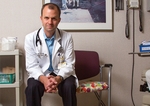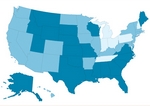business
Practices hiring despite drop in patient visits
■ Physician offices are bolstering clinical staff to generate traffic and prepare for more insured patients once health reform kicks in.
By Victoria Stagg Elliott — Posted Sept. 20, 2010
- WITH THIS STORY:
- » Seeming contradiction
- » Related content
Doctor visits are down. But hiring in physician offices is up.
Experts suspect that this seemingly counterintuitive staffing trend is the result of practices adding clinical professionals to stay financially viable in this economic downturn, while preparing for health system reform implementation.
"A lot of physician offices are restructuring and still hiring absolutely critical positions that they cannot go without, but they have eliminated noncritical positions, particularly in administration," said Rocky Barra, oncology practice manager at Monte Verde Partners Group in Oakland, Fla. He handles hiring for oncology practices nationally.
Preparing for the implementation of health system reform is playing a role, because hiring physicians and other types of clinicians can take six months to a year or more. Some practices are starting this process to be ready to treat the extra patients expected to have insurance when the law is fully in place in 2014.
"A fair number of practices are hiring because of anticipated demand," said Tommy Bohannon, vice president of hospital-based recruiting with the physician placement firm Merritt Hawkins & Associates in Irving, Texas.
However, experts say physicians are being cautious not only about which positions they are hiring for, but also about how many positions they are adding. That's because not every practice is certain that health reform will bring more patients. Physicians are staring at a possible 23% cut in Medicare pay as of Dec. 1, and an additional 6.5% cut on top of that as of Jan. 1, 2011, unless Congress overturns those reductions.
In the immediate future, some practices don't want to add expenses with patient visits showing no sign of becoming more frequent.
"As I'm talking to physicians, I still sense a wariness," Barra said.
Long-term trend in falling visits
A Deutsche Bank Securities report "Health Care Providers: July physician office visit survey data remain soft" issued Aug. 31 found that visits to physician offices were down 7.3% in July compared with a year ago. April, May and June had similar declines. According to Deutsche Bank, eight of the previous 10 months recorded the same kinds of drops in patient visits.
"Patient volumes have really remained pretty weak in 2010," said Darren Lehrich, one of the report's authors and a senior analyst and managing director at Deutsche Bank.
The report was issued primarily so investors in companies that could be affected by these trends, such as those providing laboratory services, would know how stocks might be affected.
Though various surveys have noted a decline in visits due to patients losing insurance as they became unemployed, the nation's largest publicly traded health insurance companies noted in their second-quarter earnings that even their own members were spending less on health care.
The Thomson Reuters Consumer Healthcare Sentiment Index, which tracks how patients feel about their ability to pay, hit a new low of 95 in July. One hundred is the baseline.
"This is conjecture, but for a while, people had other forms of coverage, such as [the Consolidated Omnibus Budget Reconciliation Act] or other savings and were getting their routine physicals. Now that's just being deferred," said Gary Pickens, PhD, chief research officer of Thomson Reuters Center for Health Care Analytics. "They may think, 'I have been unemployed for a year or more. I'm not going to get this done, and I'm going to restrict my use of health care services to things that are urgent.' "
Uptick in hiring
The decline in patient visits is not a drag on practice hiring, despite the loss of revenue from less traffic. Instead, the hiring trend is the reverse of the situation with patient visits: In eight of the last 10 months up to July, medical offices increased staff, according to the Bureau of Labor Statistics, which counts the employed and unemployed for the U.S. Dept. of Labor.
In August, 5,300 jobs were added in physicians' offices, according to the BLS. That's the largest gain of 2010. While the 9,300 jobs added in the summer of 2010 weren't as high as the more than 15,000 added the previous summer, experts said the growth was still better than most industries.
The BLS numbers, like Deutsche Bank's survey, did not track practices by specialty. However, experts believe most of the growth is happening in practices offering primary care, such as the Webster City (Iowa) Medical Clinic.
Unlike other practices, Webster City has seen a 10% increase in visits in the last year. Slightly less than half of that is patients gained through a local physician's retirement.
But Webster City is going beyond that patient bump with its plans to add to its four physicians (three primary care and one specialist) and 42 other staffers. The clinic says it wants to add three or four more physicians. and the clinical and administrative staff to support them.
"We believe there will be more demand, and we're trying to staff for that," said Paula Chuchvara, the clinic's administrator.
Webster City is expecting that demand in the form of more insured patients because of health reform expansions. Experts said doctors are adding clinical staff to attract more patients -- and thus generate more revenue.
In another possible trend, however, there are some signs that physician offices could be on the verge of an end-of-the-year hiring lull, particularly as possible Medicare pay cuts loom.
A report issued Sept. 1 by the Conference Board on online job advertising found that listings for health care practitioners, a category that includes physicians, declined from 574,000 in July to 542,500 in August. The number of ads for health care support personnel dropped from 111,800 to 108,900. Those who wrote the report cautioned, however, that it was unclear how significant this dip is, because longer-term trends remain positive.













